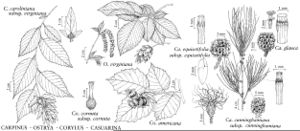Ostrya
Fl. Carniol., 414. 1760, name conserved.
Trees, 9–18 m; trunks usually 1, branching mostly deliquescent, trunk and branches terete. Bark of trunk and branches brownish gray to light-brown, thin, smooth, breaking and shredding into shaggy vertical strips and scales; lenticels generally inconspicuous. Wood nearly white to light-brown, very hard and heavy, texture fine. Branches, branchlets, and twigs conspicuously 2-ranked; young twigs differentiated into long and short-shoots. Winter buds sessile, ovoid, somewhat laterally compressed, apex acute; scales many, imbricate, longitudinally striate. Leaves on long and short-shoots, 2-ranked. Leaf-blade narrowly ovate to ovate, elliptic, or obovate with 10 or more pairs of lateral-veins, 2.5–13 × 1.5–6 cm, thin, margins doubly serrate to serrulate; surfaces abaxially glabrous to tomentose. Inflorescences: staminate catkins terminal on branches, mostly in small, racemose clusters, formed previous growing season and exposed during winter, expanding with leaves; pistillate catkins proximal to staminate on short, lateral, leafy new growth, solitary, ± erect, elongate, bracts and flowers uncrowded. Staminate flowers in catkins 3 per bract, crowded together on pilose receptacle; stamens 3 (–6), short; filaments often divided part-way to base; anthers divided into 2 parts, each 1-locular, apex pilose. Pistillate flowers 2 per bract. Infructescences loosely imbricate, strobiloid clusters of closed inflated bracts; clusters pendulous, elongate; bracts deciduous with fruit, inflated, bladderlike, each bract enclosing 1 fruit. Fruits small nutlets, ovoid, longitudinally ribbed, often crowned with persistent sepals and styles. x = 8.
Distribution
Mostly north temperate zones
Discussion
Species ca. 5 (3 in the flora).
In North America Ostrya consists of small trees in the northern temperate deciduous forest zone and in the mountains of southwestern United States and adjacent Mexico. Mexican populations have generally been treated as conspecific with O. virginiana of eastern United States and Canada. They differ in various respects, however, including leaf shape and indumentum; the morphologic variation and phytogeography of the complex as a whole should be carefully examined. Ostrya carpinifolia Scopoli is a common and important forest tree of southern Europe.
Ostrya shares many features with Carpinus. The staminate catkins in most species of Ostrya are produced the season before anthesis but, unlike Carpinus, they are exposed during the winter. Dispersal occurs as it does in Carpinus, except that the bracts form closed, bladderlike structures rather than flat wings.
The wood of Ostrya is used for fuel, fence posts, and various other purposes. It was formerly utilized for manufacturing items subject to prolonged friction, including sleigh runners, wheel rims, and airplane propellers. Because of its hardness, it has been used for tool handles, mallet heads, and other hard wooden objects.
Selected References
None.
Lower Taxa
Key
| 1 | Leaf blade (5–)8–10(–13) cm, apex usually abruptly acuminate; infructescences 3.5–6.5 cm; e, nc United States, adjacent Canada. | Ostrya virginiana |
| 1 | Leaf blade 2.5–6.5 cm, apex acute, obtuse, or rounded; infructescences 2–4 cm; sw United States. | > 2 |
| 2 | Leaf blade ovate or broadly ovate-elliptic to broadly elliptic to nearly orbiculate; petiole and young twigs often bearing stipitate glands; staminate catkins 2–3 cm; w Texas, New Mexico, Arizona, Utah. | Ostrya knowltonii |
| 2 | Leaf blade elliptic to elliptic-lanceolate; petiole and young twigs without stipitate glands; staminate catkins 3.5–5 cm; endemic to Chisos Mountains in Big Bend National Park, Texas. | Ostrya chisosensis |
